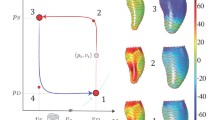Abstract
The deformation of myocard takes a vital part in the pumping function of the heart muscle. Knowledge of myocard anatomy and physiology makes it possible to create models of cardiac behavior. These models can be used for surgery planning, educational and research purposes. Simulations can be performed, which are beyond the capability of physical experiments. Volume models of myocard are necessary for realistic simulations. The deformation model presented in this work is based on a mass spring system parameterized by a continuum mechanics deformation model. Electrophysiology and excitation propagation of myocard were simulated and the resulting force development was used as input for the deformation models. Electromechanical coupled simulations with simple myocard geometries were carried out to show the capability of the deformation model in reconstruction of cardiac deformation.
Access this chapter
Tax calculation will be finalised at checkout
Purchases are for personal use only
Preview
Unable to display preview. Download preview PDF.
Similar content being viewed by others
References
A. L. Hodgkin and A. F. Huxley, “A quantitative description of membrane current and its application to conduction and excitation in nerve,” J. Physiol, vol. 177, pp. 500–544, 1952.
D. Noble, A. Varghese, P. Kohl, and P. Noble, “Improved guinea-pig ventricular cell model incorporating a diadic space, I Kr and IKs, and length-and tension-dependend processes,” Can. J. Cardiol., vol. 14, pp. 123–134, Jan. 1998.
C. S. Henriquez, A. L. Muzikant, and C. K. Smoak, “Anisotropy, fiber curvature and bath loading effects on activation in thin and thick cardiac tissue preparations: Simulations in a three-dimensional bidomain model,” J. Cardiovascular Electrophysiology, vol. 7, pp. 424–444, May 1996.
A. F. Huxley, “Muscle structures and theories of contraction,” Prog. Biophys. and biophys. Chemistry, vol. 7, pp. 255–318, 1957.
J. J. Rice, R. L. Winslow, and W. C. Hunter, “Comparison of putative cooperative mechanisms in cardiac muscle: length dependence and dynamic responses,” Am. J. Physiol. Circ. Heart., vol. 276, pp. H1734–H1754, 1999.
F. B. Sachse, G. Seemann, and C. D. Werner, “Combining the electrical and mechanical functions of the heart,” Int. J. Bioelectromagnetism, vol. 3, No. 2, 2001.
M. Mohr, “Vergleich von mikroskopischen und makroskopischen Modellen der Deformation im Myokard,” Diploma Thesis, Universitat Karlsruhe, Institut fur Biomedizinische Technik, Universitat Karlsruhe (TH), Sept. 2001.
D. Bourguignon and M.-P. Cani, “Controlling anisotropy in mass-spring systems,” in Computer Animation and Simulation’ 00, Proc. 11th Eurographics Workshop, Interlaken, Switzerland, Springer Computer Science, pp. 113–123, Springer, Aug. 2000.
K.-J. Bathe, Finite Element Procedures. Upper Saddle River, New Jersey: Prentice Hall, 1996.
Author information
Authors and Affiliations
Editor information
Editors and Affiliations
Rights and permissions
Copyright information
© 2003 Springer-Verlag Berlin Heidelberg
About this paper
Cite this paper
Mohr, M.B., Blümcke, L.G., Seemann, G., Sachse, F.B., Dössel, O. (2003). Volume Modeling of Myocard Deformation with a Spring Mass System. In: Ayache, N., Delingette, H. (eds) Surgery Simulation and Soft Tissue Modeling. IS4TM 2003. Lecture Notes in Computer Science, vol 2673. Springer, Berlin, Heidelberg. https://doi.org/10.1007/3-540-45015-7_32
Download citation
DOI: https://doi.org/10.1007/3-540-45015-7_32
Published:
Publisher Name: Springer, Berlin, Heidelberg
Print ISBN: 978-3-540-40439-2
Online ISBN: 978-3-540-45015-3
eBook Packages: Springer Book Archive




